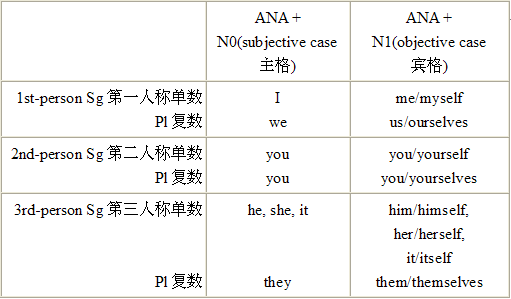|
第二章 句子 |
|
|
第十一课 照应
11-1 [重复和重复法则#1~#3]
当英语中一种表达被重复时,以下三种法则中至少一种被应用。例句中都是重复的名词。
(i) 重复相同的表达。[Equi Rule #1]
(1) John ordered a Big Mac and two cokes. Mary had a Big Mac/
*it and one coke.
约翰点了一个巨无霸和两杯可乐。玛丽点了一个巨无霸和一杯可乐。
(2) You don't need sulfur for drying apricots; sulfur(=/=it)
ruins the flavor.
你不需要用硫磺来弄干杏。(Bolinger,1979,p.291)
(ii) 使用替代形式。 [Equi Rule #2]
(3) John works for Baskin-Robbins. He likes ice cream.
约翰在“Baskin-Robbins 31种美国风味冰激凌店”工作。他喜欢冰激凌。
(4) Susan believed in herself. 苏珊相信她自己。
(iii) 删去重复部分留出空格gap(
在英语中,一般来说,简单的重复被认为是不适当的。因此,Equi Rule法则#2和/或Equi Rule法则#3的运用就很普遍。 (5)和(6)中的空格我们将在15-2 和 27-2进一步分别讨论。11-2 [重复法则 #2和照应形式] 在这一部分,我们将像在(3)中一样检查Equi Rule法则 #2。
(7) a. John works for Baskin-Robbins. *John likes ice cream.
b. John works for Baskin-Robbins. He likes ice cream.(=(3))
c. John works for Baskin-Robbins. *
约翰在“Baskin-Robbins 31种美国风味冰激凌店”工作。他喜欢冰激凌。当"He"和"John"是同一个人时,(7a)和(7c)都是不正确的。在英语中,当简单的重复显得笨拙的时候,我们通常使用一个替代物。替代物的形式被称作 “照应形式” ,即anaphoric form。照应形式,换句话说,就是运用Equi Rule #2的替代物。 我们认为照应形式是由N EPD{Anaphora}或ANA引发的,请看(7b)的分析如下:
(8) ANA + John
树形图:
(9) (He)
N
/ \
EPD[ANA] N
(John)
11-3 [N扩充子{照应}(ANA)和性/数/人称/格照应] 照应形式应该与名词的性,数和人称相协调。
(10) a. Mary works for Baskin-Robbins;she/*he likes ice cream.
玛丽在Baskin-Robbins 31种美国风味冰激凌店工作,
她喜欢冰激凌。 (Gender性)
b. Jim and Mary work for Baskin-Robbins;they/*he like ice
cream.
吉姆和玛丽在Baskin-Robbins 31种美国风味冰激凌店工作;
他们喜欢冰激凌。 (Number数)
c. I work for Baskin-Robins;I/*you like ice cream.
我在Baskin-Robbins31种美国风味冰激凌店工作,
我喜欢冰激凌。 (Person人称)
名词的照应形式经常根据它是否位于动词前面而发生形式改变。当一个动词的模式是"VZ + N"或者当一个句子的模式是"N0 + VZ + N1"时,有时照应形式将呈现不同的形式:
(11) a. John likes Mary; he/*him likes tall girls.
约翰喜欢玛丽;他喜欢高个子的女孩。 (Case格)
b. John is a nice boy; everybody likes him/*he.
约翰是个好男孩;每个人都喜欢他。
在N0位置中的照应形式叫做 “主格” subjective case,在N1位置中的则叫做 “宾格” 。在像"of", "on", "with"这样的N-A(D) 转换子之后,名词需要使用宾格,而不是主格。
(12) John and Mary are a nice couple; everybody speaks well of
them/*they.
约翰是玛丽是很好的一对夫妇;每个人都说他们好。以上的前方呼应形式由“扩充子 {前方呼应}”或 ANA产生,如下:
(13) a. ANA + Mary
以下表格表示名词的前方呼应形式。
<Anaphoric Forms of Nouns名词的照应形式(to be revised待修改)>
(14)
11-4 [-self/-selves] 当照应形式出现在同一句子中的两个同一名词中,第二个名词应变成"-self/selves"形式,如下:
(15) Susan believed in herself/*her/*Susan. (=(4))
苏珊相信她自己。
(16) Max and Dex gave a Christmas gift to themselves/*them
/*Max and Dex.
马克思和德克斯给他们自己送圣诞礼物。
如此,在一个句子中,照应形式依下改变。
(17)a. me 我 → myself 我自己
b. us 我们 → ourselves 我们自己
c. you 你 → yourself 你自己/yourselves 你们自己
d. him 他 → himself 他自己
e. her 她 → herself 她自己
f. it 它 → itself 它自己
g. them 他们/她们/它们 → themselves 他们/她们/它们自己
因此,表格(14)应该修改如下:
<Anaphoric Forms of Nouns 名词的照应形式 (revised 待修改)>
(18)
11-5 [其它照应形式] 名词的其它照应形式为:
(i) <ANA+N>
(19) Jack and Mary loved each other.
杰克和玛丽彼此相爱。
(20) I lost my watch. I have to buy a new one.
我丢了手表,必须买一块新的。
(21) What's the difference between the education system in
Japan and that in the U.S.?
日本和美国的教育体制有何不同?
其它种类词性的照应形式:
(ii) <ANA+A>
(22) A: Are you tired? 你累吗?
B: Less so than yesterday. 没昨天累。
(23) This book has twenty mistakes on as many pages.
这本书二十页中有二十个错误。
(24) a. Ann introduced a tall man but I don't remember his name.
安介绍给我一位高个子男士,但我不记得他的名字了。
b. We visited the new couple, Dex and Sue. They kindly
showed us around their new house.
我们拜访了一对新婚夫妇,德克斯和休。他们非常亲切地带
我们参观了他们的新房子。
(iii) <ANA+V>
(25) A: Will you drop in at my office? 你要不要顺便到我办公室看看?
B: I'll be glad to do so. 我很乐意。
(iv) <ANA+AD>
(26) A: Will you speak a little more slowly? 你能说慢点儿吗?
B: I'm trying to do so. 我在尽力。
(27) Bill moved to Denver in 1970 and he met Mary then and
there.
比尔1970年搬到到丹佛,那时候他在那儿遇到了玛丽。
11-6 [后方照应] 照应的顺序通常从前往后的。然而,在某些情况下,可以倒过来。
(28) It's delicious, this coffee. 很好喝,这杯咖啡。
所谓上述的后方照应,即backward anaphora,有时是可以随意选择的。
(29) a. It's expensive to live in a big city.
b. =To live in a big city is expensive. 住在大城市很贵。
(30) a. It's obvious that John told a lie.
b. =That John told a lie is obvious. 约翰说谎是很明显的。
然而,有时候它是固定不可选择的。
(31) a. It seems that John is ill in bed. 看起来约翰病倒在床了。
b. *That John is ill in bed seems.
|
|
Copyright(C) 2004 Masaya Oba. All rights reserved. |
|

